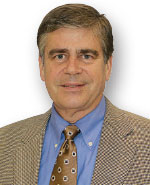Danneberger: Looking back on 2016

Karl Danneberger, Ph.D.
I thought I would share some things that have stuck in my mind from this past year. My thoughts are a potpourri of anecdotal and observational thoughts not backed by facts, which should provide fodder for a winter of conversation.
Quilted look of the intermediate rough
This issue came to a head this past spring on cool-season tournament courses appearing on television. The intermediate rough, also known as the first cut of rough or 84-inch cut, is mowed at a height within the adaptive range of several turfgrasses. For example, a mowing height of 1.25 to 1.5 inches can result in Kentucky bluegrass, perennial ryegrass, annual bluegrass, rough bluegrass and creeping bentgrass coexisting to some degree. These grasses will not integrate among each other in a uniform distribution pattern, but occur as patches. In spring, cool-season turfgrasses show a diversity of colors like the fall colors of trees. These patches of grasses appear as a hodgepodge of colors and textures.
On televised golf tournaments, the variety of colors and textures of the grasses mentioned above and the quilted appearance of the intermediate rough stands in stark contrast to the uniform appearance of the fairways and primary rough. This is not an issue for 99 percent of courses, but those few golf courses under the spotlight increasingly are trying to figure out what to do. My limited observation of this process has lead me to believe there are few options, with none of them being cheap.
Return of the “American” golf course. This year’s U.S. Open at Oakmont Country Club, the PGA Championship at Baltusrol Golf Club and the U.S. Senior Open at Scioto Country Club brought focus to what American golf is. These courses in all their magnificent grandeur, highly manicured turf and in-your-face type of tough golf challenge reminded us of the American golf identity. Outside of the United States, when golfers think of American golf, they think of these types of golf courses.
Fate of family owned public golf courses. One part of the golf course industry hardest hit has been family owned public golf courses. Recovery of this market since 2008-2009 has been discouraging and stagnant. This fall, however, I’ve had a few families who own golf courses here in Ohio tell me that this has been the best year they have had since the 1990s. One course owner said they are looking to buy new equipment for the first time in a long time. The reasons: (1) With gas prices down, golfers are willing to drive to play golf; (2) Due to golf course closures (competitors), remaining courses are picking up golfers; (3) Although it’s been a tough year to maintain turf, there’s been great weather to play golf.
It’s hoped that as the industry begins to recover, those remaining courses will come out of this in better financial health.
Bacterial decline on creeping bentgrass. The weather in Ohio during 2011 was extremely hot, with thunderstorms occurring intermittently, resulting in heavy downpours. Several golf courses faced significant turf loss, with much of that attributed to bacterial decline caused by the bacteria Acidovorax. The year 2012 was basically a repeat of 2011. Since 2012 we have done considerable work on this disease. After another frustrating field season, I’ve reached the conclusion that bacterial decline on creeping bentgrass is not a big deal.
I could put in a bunch of qualifiers and say that in other places the story may be different than what we’ve found. But golf course management programs over the last four or five years have changed to address extreme weather fluctuations and have indirectly influenced the occurrence of this disease. I guess I will put in a qualifier and say we need a brutal summer to know for sure if it can kill a lot of turf.








